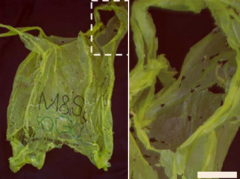Plastic polymers are ubiquitous in our lives, and while their resilience makes them ideal for a variety of uses, finding means to effectively dispose of them represents a major challenge. Recently, a variety of plastivore insects have been discovered that possess the remarkable ability to consume and rapidly degrade petro plastics. Focusing on the caterpillar larvae of the greater wax moth (Galleria mellonella) — known as wax worms — and low-density polyethylene, scientists explored how much plastic is consumed, the relative contributions from the insect and its microbiome to the biodegradation process, and the impacts of plastic ingestion on larval fitness.

Polyethylene degradation by wax worms. Left: plastic bag after exposure to about 100 wax worms for 12 hours; Right: magnification of the area indicated in the image at left. Image credit: Bombelli et al, doi: 10.1016/j.cub.2017.02.060.
Plastics play a fundamental role in modern life, but their resistance to biodegradation makes them very difficult to dispose of.
In 2017, biologists demonstrated that the caterpillars of the greater wax moth can degrade polyethylene plastic.
Polyethylene is the world’s most commonly manufactured plastic, with over 100 million tons of polyethylene produced globally each year.
This plastic is chemically resilient, which makes it resistant to decomposition and can take decades or even hundreds of years to fully degrade.
“Around 2,000 wax worms can break down an entire polyethylene bag in as little as 24 hours, although we believe that co-supplementation with feeding stimulants like sugars can reduce the number of worms considerably,” said Dr. Bryan Cassone, a biologist at Brandon University.
“However, understanding the biological mechanisms and cons




